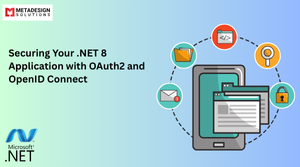Introduction
Modern .NET applications require flexibility, scalability, and maintainability. One of the key principles that help achieve this is Dependency Injection (DI), a technique that enables efficient management of object dependencies. Inversion of Control (IoC), a broader concept, ensures that control over object creation and lifecycle management is handled by a container rather than the application itself.
For businesses developing enterprise-grade applications, implementing DI and IoC correctly reduces tight coupling, simplifies unit testing, and enhances code maintainability. Many companies prefer to hire .NET developers or partner with a .NET development company to implement these principles effectively.
Additionally, ML.NET Introduction brings machine learning capabilities to .NET applications, allowing developers to integrate AI-driven features such as predictive analytics, anomaly detection, and recommendation systems seamlessly.
In this article, we’ll explore:
✅ What Dependency Injection (DI) and Inversion of Control (IoC) are
✅ How they improve .NET applications
✅ Different types of DI and IoC containers
✅ Best practices and common pitfalls
What is Dependency Injection (DI) in .NET?
Definition
Dependency Injection (DI) is a design pattern where an object’s dependencies are provided from an external source rather than created within the object itself. This helps in reducing tight coupling and improving code reusability.
Example Without Dependency Injection
In a tightly coupled application, one class creates an instance of another class:
csharp
public class EmailService
{
public void SendEmail(string message)
{
Console.WriteLine($"Email sent: {message}");
}
}
public class Notification
{
private EmailService _emailService;
public Notification()
{
_emailService = new EmailService();
}
public void Send(string message)
{
_emailService.SendEmail(message);
}
}
Build High-Performance APIs in ASP.NET Core
Need secure and scalable RESTful APIs? Book a meeting with MDS to follow best practices in .NET API development.
🔹 Problem: The Notification class is directly dependent on EmailService, making it difficult to replace or test.
Example With Dependency Injection
With DI, we inject the EmailService into Notification, improving flexibility:
csharp code:
public class Notification
{
private readonly IEmailService _emailService;
public Notification(IEmailService emailService)
{
_emailService = emailService;
}
public void Send(string message)
{
_emailService.SendEmail(message);
}
}
Now, the Notification class does not create an instance of EmailService. Instead, the dependency is injected from outside.
✅ Benefits:
- Loosely coupled – Notification does not directly depend on EmailService.
- Easier to test – You can inject a mock email service for unit testing.
- More maintainable – Replacing EmailService with another service is straightforward.
Many businesses looking to hire .NET developers focus on DI implementation to ensure scalable and testable applications.
Understanding Inversion of Control (IoC)
Definition
Inversion of Control (IoC) is a broader principle where the control of object creation and dependency management is shifted from the application to a container. Dependency Injection (DI) is one of the most common implementations of IoC.
Example: Instead of manually managing object lifetimes, an IoC container (like Microsoft.Extensions.DependencyInjection) does it automatically.
Types of Dependency Injection in .NET
1. Constructor Injection (Most Common Approach)
Dependencies are provided through the constructor.
✅ Example:
csharp code:
public class Notification
{
private readonly IEmailService _emailService;
public Notification(IEmailService emailService)
{
_emailService = emailService;
}
}
📌 Best For: Most cases, as it ensures dependencies are ready when the object is created.
2. Property Injection
Dependencies are set via public properties after object creation.
✅ Example:
csharp code:
GET /products
POST /products
2. Implement Status Codes Correctly
Use standard HTTP status codes for clarity.
Status Code | Meaning |
200 OK | Request successful |
201 Created | Resource created successfully |
400 Bad Request | Invalid request data |
404 Not Found | Resource not found |
500 Internal Server Error | Server error |
✅ Example:
csharp code:
if (product == null) return NotFound();
return Ok(product);
3. Use Dependency Injection for Better Maintainability
ASP.NET Core natively supports Dependency Injection (DI), making APIs loosely coupled and testable.
✅ Example: Register a service in Program.cs:
csharp code:
builder.Services.AddScoped<IProductService, ProductService>();
Inject it into the controller:
csharp code:
public class ProductsController : ControllerBase
{
private readonly IProductService _productService;
public ProductsController(IProductService productService)
{
_productService = productService;
}
}
4. Implement Pagination for Large Datasets
Avoid sending huge datasets in a single response. Implement pagination to improve performance.
✅ Example:
csharp
[HttpGet]
public IActionResult GetProducts(int page = 1, int pageSize = 10)
{
var pagedProducts = Products.Skip((page - 1) * pageSize).Take(pageSize);
return Ok(pagedProducts);
}
5. Secure Your API with Authentication & Authorization
Use JWT (JSON Web Tokens) for secure authentication.
✅ Install JWT Authentication:
bash code:
dotnet add package Microsoft.AspNetCore.Authentication.JwtBearer
✅ Configure in Program.cs:
csharp code:
builder.Services.AddAuthentication(JwtBearerDefaults.AuthenticationScheme)
.AddJwtBearer(options =>
{
options.Authority = "https://your-auth-provider.com";
options.Audience = "your-api";
});
✅ Secure an API Endpoint:
csharp code:
[Authorize]
[HttpGet]
public IActionResult GetSecureData()
{
return Ok("This is a secure endpoint");
}
📌 Why? JWT ensures only authorized users access protected endpoints.
6. Use API Versioning
As your API grows, versioning prevents breaking changes for existing users.
✅ Install Versioning Package:
bash code:
dotnet add package Microsoft.AspNetCore.Mvc.Versioning
✅ Enable Versioning in Program.cs:
csharp code:
builder.Services.AddApiVersioning(options =>
{
options.DefaultApiVersion = new ApiVersion(1, 0);
options.AssumeDefaultVersionWhenUnspecified = true;
options.ReportApiVersions = true;
});
✅ Define API Versions:
csharp code:
[ApiVersion("1.0")]
[Route("api/v{version:apiVersion}/products")]
public class ProductsV1Controller : ControllerBase
{
[HttpGet]
public IActionResult Get() => Ok("Products from API v1");
}
[ApiVersion("2.0")]
[Route("api/v{version:apiVersion}/products")]
public class ProductsV2Controller : ControllerBase
{
[HttpGet]
public IActionResult Get() => Ok("Products from API v2");
}
📌 Why? Clients can continue using older versions while new features are introduced.
7. Enable Caching for Better Performance
Caching reduces API response time and improves performance.
✅ Enable Response Caching in Program.cs:
csharp code:
builder.Services.AddResponseCaching();
✅ Apply Caching to an API Endpoint:
csharp code:
[ResponseCache(Duration = 60)]
[HttpGet]
public IActionResult GetProducts()
{
return Ok(Products);
}
📌 Why? Reduces database queries and speeds up frequently accessed data.
Why Hire a .NET Development Company for API Development?
Building secure, scalable, and high-performance APIs requires expertise in .NET Core, API security, and best practices.
Benefits of Hiring .NET Developers:
✅ Custom API development tailored to business needs
✅ Secure authentication & authorization setup
✅ Performance optimizations & caching implementation
✅ Long-term API maintenance & support
Many companies hire .NET developers to ensure their APIs are scalable, secure, and future-proof.
Conclusion
Building RESTful APIs in ASP.NET Core requires best practices for security, scalability, and performance. By implementing proper routing, authentication, versioning, and caching, businesses can deliver high-quality APIs that support modern applications.
If you need an experienced .NET development company to build secure and scalable APIs, hiring .NET experts ensures that best practices are followed.
💡 Need expert .NET developers? Hire a .NET development team today! 🚀
Related Hashtags:
#DotNet #AspNetCore #API #WebAPI #RESTfulAPI #Microservices #SoftwareDevelopment #HireDotNetDevelopers #DotNetDevelopmentCompany #CSharp #APISecurity #BackendDevelopment #TechSolutions



